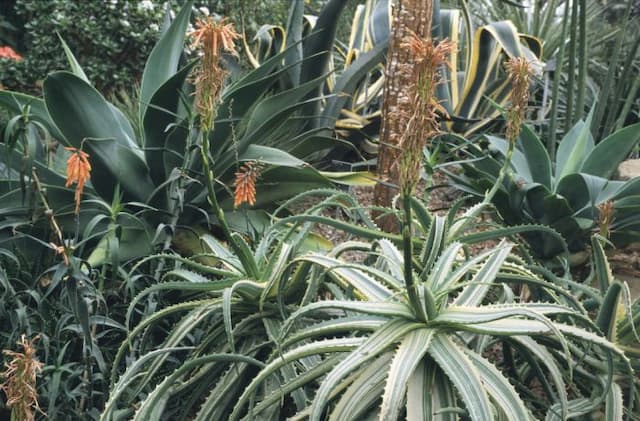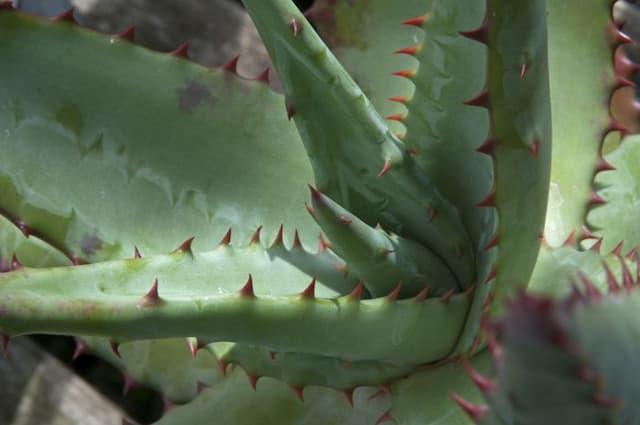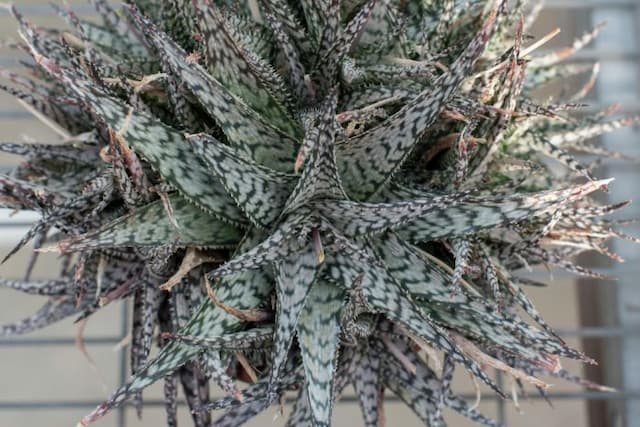Caulescent red-hot poker 'John May' Kniphofia caulescens 'John May'

ABOUT
'John May' is an evergreen perennial to 1m tall with long, grey-green leaves. In summer and autumn, the stout, bronze-tinged stems bear heads of pinky-bronze buds opening to coral-red flowers fading to yellow with age
About this plant
 Names
NamesFamily
Asphodelaceae.
Synonyms
Red Hot Poker, Torch Lily, Poker Plant.
Common names
Kniphofia caulescens
 Characteristics
CharacteristicsLife cycle
Perennials
Foliage type
Evergreen
Color of leaves
Blue-green
Flower color
Orange
Height
2-3 feet [60-90 cm]
Spread
1-2 feet [30-60 cm]
Plant type
Herb
Hardiness zones
5
Native area
South Africa
Benefits
 General Benefits
General Benefits- Aesthetic Appeal: The striking flowers and architectural foliage of Kniphofia caulescens 'John May', also commonly known as Red Hot Poker, add visual interest to the garden.
- Attracts Pollinators: Red Hot Poker flowers are known for attracting bees, butterflies, and hummingbirds, promoting biodiversity.
- Drought Tolerance: Once established, Red Hot Poker plants are quite drought-tolerant, making them suitable for water-wise gardens.
- Low Maintenance: They require minimal care once settled in the right conditions and soil, reducing gardening effort.
- Deer Resistant: Their foliage and flowers are not favored by deer, making them a good choice for gardens in areas with deer pressure.
- Seasonal Color: They provide a burst of color in the garden during their blooming period, adding to the seasonal dynamism of a landscape.
- Easy to Propagate: Red Hot Pokers can easily be propagated by division, making it simple to multiply your plants and share with fellow gardeners.
 Medical Properties
Medical PropertiesThis plant is not used for medical purposes.
 Air-purifying Qualities
Air-purifying QualitiesThis plant is not specifically known for air purifying qualities.
 Other Uses
Other Uses- Kniphofia, also known as Red Hot Poker, can be used as a natural pest deterrent—its robust smell and taste can repel certain herbivores from gardens.
- In dye production, the vibrant colors of Red Hot Poker flowers can be used to create a natural dye for fabrics and textiles.
- As a teaching tool for pollination, the distinct flower structure of the Red Hot Poker is excellent for educational purposes in botany classes or nature workshops.
- Red Hot Poker can serve as a focal point in garden design, adding a vertical element and a splash of color to landscapes.
- Some photographers and artists may use Red Hot Poker flowers as subjects due to their dramatic appearance and striking color gradations.
- Kniphofia can be used in a flower arrangement as a long-lasting fresh cut flower due to its sturdy stems and long bloom time.
- In xeriscaping, Red Hot Poker is ideal as it requires minimal watering once established, helping to conserve water in arid climates.
- The dried seed pods of Red Hot Poker can be used in craft projects, such as making wreaths or as additions to dried flower arrangements.
- The structural foliage and flower spikes of Red Hot Poker can be used to add texture and contrast in floral photography and botanical illustration.
- In culinary events, Red Hot Poker flowers can be used as natural decor for food platters, adding an exotic, vibrant touch to presentation.
Interesting Facts
 Feng Shui
Feng ShuiThe Red Hot Poker is not used in Feng Shui practice.
 Zodiac Sign Compitability
Zodiac Sign CompitabilityThe Red Hot Poker is not used in astrology practice.
 Plant Symbolism
Plant Symbolism- Standing Out: Kniphofia, also known as Red Hot Poker, has a distinctive and striking appearance with its bright flower spikes. Its symbolism often represents the ability or the desire to stand out in a crowd and be noticed.
- Attraction: The vivid colors of the Red Hot Poker can be symbolic of attraction or the act of drawing attention, making it a symbol for those wanting to command presence or exude confidence.
- Warmth: Given its common name and fiery-colored blooms, the Red Hot Poker can symbolize warmth and comfort, much like an inviting fire on a cold day.
 Water
WaterThe Red Hot Poker plant requires consistent moisture during its growing season (spring and summer), and it is recommended to water it approximately once a week with about 1 inch of water. However, watering frequency may need to increase during periods of extreme heat or drought, ensuring that the soil does not dry out completely. It's important to avoid waterlogging, so well-draining soil is essential. During the dormant season in fall and winter, reduce watering to prevent root rot, providing enough water to keep the soil slightly moist.
 Light
LightThe Red Hot Poker thrives best in full sunlight, where it can receive at least 6 hours of direct light daily. This plant enjoys a spot that is exposed to the morning sun and has some protection from the intense afternoon heat, although it can tolerate full sun exposure throughout the day. Avoid planting it in deep shade, as insufficient light can lead to poor bloom production and a weakened plant.
 Temperature
TemperatureRed Hot Pokers are hardy plants that can withstand temperatures down to about -20 degrees Fahrenheit and up to approximately 100 degrees Fahrenheit; however, they thrive in milder temperatures between 50 and 75 degrees Fahrenheit. They are well-adapted to various climates but prefer to avoid extreme cold or frost without protection.
 Pruning
PruningPruning is mainly done to remove spent flower stalks and maintain the Red Hot Poker's tidy appearance. Cut back the flower spikes as they fade, which can encourage reblooming. In late fall or early winter, remove any dead or damaged foliage to prepare for new growth in spring. Pruning is typically performed annually or as needed.
 Cleaning
CleaningAs needed
 Soil
SoilRed Hot Poker thrives in well-draining soil with a pH ranging from 6.0 to 6.5. A mixture of loam, sand, and compost is ideal, ensuring adequate drainage and fertility to sustain its growth and flowering.
 Repotting
RepottingRed Hot Poker typically doesn't require frequent repotting and can be done every 2-3 years or when it outgrows its current container, ensuring minimal disturbance to its roots.
 Humidity & Misting
Humidity & MistingRed Hot Poker prefers moderate humidity levels but is quite adaptable and can tolerate the humidity levels typically found in outdoor environments without the need for any special adjustments.
 Suitable locations
Suitable locationsIndoor
Provide bright light and good airflow for healthy growth.
Outdoor
Plant in full sun, ensure well-drained soil, and protect from severe frost.
Hardiness zone
5-9 USDA
 Life cycle
Life cycleKniphofia caulescens 'John May', commonly known as Red Hot Poker, begins its life cycle as a seed, which germinates when exposed to the right conditions of warmth and moisture. The plant then develops a basal rosette of narrow, arching leaves, and as it matures, fleshy rhizomes form and spread to establish a larger clump. In the flowering stage, tall, sturdy stalks grow from the rosette, each topped with a spiky inflorescence consisting of tubular flowers that usually bloom from the bottom up, displaying hues of red, orange, or yellow. After pollination, primarily by birds and insects, the flowers produce seeds that can spread to form new plants. In the perennial phase, after flowering, the plant will go dormant during colder months, with the leaves dying back, and then will regrow from the rhizome in the spring. Over the years, Red Hot Poker will continue this annual cycle of growth, flowering, and dormancy, slowly expanding in size and number of flowering stalks.
 Propogation
PropogationPropogation time
Late spring to early summer
Propogation: The most popular method of propagating the Red Hot Poker 'John May' is by division. Spring or early autumn is the ideal time to divide the clumps, which allows the plants to establish their roots in moderate temperatures. To propagate, carefully lift the clump using a spade, ensuring minimal root disturbance. Gently tease apart the fans of leaves with attached roots. Each division should have at least one growth point or fan of leaves. Replant these divisions at the same depth they were growing previously, spacing them about 18 inches to 24 inches (approximately 45 to 60 centimeters) apart to allow for mature growth. Water the new divisions thoroughly to settle the surrounding soil and help reduce transplant shock.









